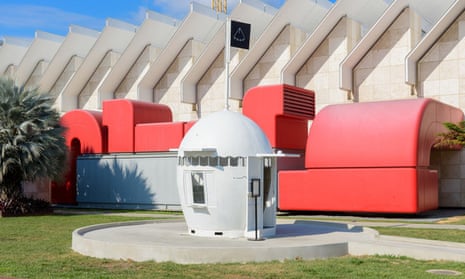One of the biggest museums in the United States is now home to one of the world’s smallest. Following a Kickstarter campaign and two weeks on the road, a life-sized replica of Guatemala City’s Nuevo Museo, an egg-shaped former kiosk that now shows contemporary art, has arrived on the Los Angeles County Museum of Art’s campus for a six-month stay.
Standing in the shadow of Lacma’s mammoth Renzo Piano-designed Resnick Pavilion at just 8ft tall and just over 6ft wide, the egg has finished a long journey that began four years ago. Three LA-based curators, Rita Gonzalez, José Luis Blondet, and Pilar Tompkins Rivas, had been traveling to Central America in preparation for the Getty’s current Latin American art-focused initiative, Pacific Standard Time: LA/LA. In Guatemala City, they met Stefan Benchoam, and later in New York Jessica Kairé, the two Guatemalan artists who in 2012 had the idea to turn the egg into a museum.
Recognizing the lack of local institutional support of the arts, they and a few artist friends had set out to launch Guatemala’s first and only contemporary art museum. “It seemed so abstract and in a way very absurd,” says Kairé. “We wondered how we would get the resources to run a museum, which in our minds then was a white cube.” By chance, they came across a “for rent” sign on a former egg-selling kiosk, and paid the first three months’ rent with the combined stipends they received for participating in a Guatemalan art biennial.
“We produced the cheapest work possible; she made hers with $50, I produced an iPhone video for $5,” says Benchoam. “And then we took the money and ran.” They called the museum Nuevo Museo, a misnomer, they say, since there was no old museum. As a cheeky reference to major art institutions, they shortened the name to NuMu, borrowing Moma’s typeface.

On a shoestring budget, they’ve averaged three or four shows per year, but never of their own work. “Our interest is in giving visibility to others,” says Benchoam, “a balance of Guatemalan artists and international artists who would resonate locally.” Exhibitions so far have featured the Guatemalan artist Regina José Galindo, Mexico City-based Pia Camil and LA-based Carolina Caycedo. The space comfortably fits one to four viewers at a time.
“The ambition was so big, even though it’s so small,” says Gonzalez. “I was really moved by these two young artists attempting to fill a void; where in Europe and Canada you tend to have state-run institutions, in Guatemala, there is such a lack of support or infrastructure for contemporary art. They basically took it on as an artists’ project to start this museum. Here we work for this behemoth, yet we really wanted the energy and dynamic that they were producing.”
Lacma invited NuMu to collaborate in A Universal History of Infamy, on view now until 18 February, at first with the idea to replicate its previous exhibitions. “When we said we could make a replica, and that we would love to drive it up ourselves,” says Benchoam, “they kind of looked at each other in silence.”
“That was the constant throughout this relationship,” says Kairé. “Although we’ve presented challenging situations, they’ve never said no.”
Through Kickstarter, the artists surpassed their $75,000 fundraising goal to hire a local architect to build a fiberglass replica, and loaded it on to a trailer. After some confusion at the Guatemalan-Mexican border, and stops at Museo Jumex in Mexico City and the Ballroom Marfa gallery in Texas, the gallery passed across the US border, and opened to the public at Lacma on 13 September. It will run until February, and afterwards, continue on as a roving American museum, or potentially stay put. “It’s been a dream,” says Benchoam, “but the dream within the dream would be to become a permanent pavilion at Lacma.”
The show on view now resounds with the sound of marimbas, the instrument of choice of Joaquín Orellana, the 86-year-old Guatemalan experimental composer whose five decades of avant garde work has been largely underappreciated in his home country. “In Guatemala, people thought he was crazy to call what he was doing music,” Benchoam says, comparing Orellana to John Cage. “Now that he’s in his 80s, we realized his whole legacy would fade if it wasn’t properly documented and archived.”
Through Kickstarter, they raised the funds to properly record Orellana’s work, restore his so-called “sound utensil” instruments, and teach young musicians how to build and play them. The exhibition on view now, Paisaje Sonoro (Sound Landscape), plays the music Orellana composed on his hacked version of the marimba and displays the invented musical notation. It’s also emblematic of NuMu’s overall mission.
“We’re going to present, support and document contemporary artists, and now the preservation of artist legacies have come into play,” says Kairé. “We’re replacing the institutional support that’s not there,” and introducing the avant garde to places where it’s still a foreign concept.
A Universal History of Infamy is on view at Lacma until 19 February 2018

Comments (…)
Sign in or create your Guardian account to join the discussion